A PAINTER OF PORTRAIT, LANDSCAPE AND STILL LIFE, Gladys Vasey received no formal training. Rather she studied nature for herself, developing a means of expression unaffected by passing trends. The more Vasey sought to acknowledge and reinforce a sound art historical tradition, the further she isolated herself from mainstream contemporary art. She believed that abstract tendencies in painting had reached an impasse. Divorced from the ordinary person, she argued, abstraction could only communicate with the initiated. She expressed concern that the ‘present trend is far too much for individualism – and not only in Art’. Painters who put themselves first, before their subject, communicate through paint but neither expect nor want an emotional response from their audience. ‘Love – which is the real message – is focused on the wrong things,’ she reasoned, ‘and there can be no revelation of reality or of “truth’s superb surprise”!’
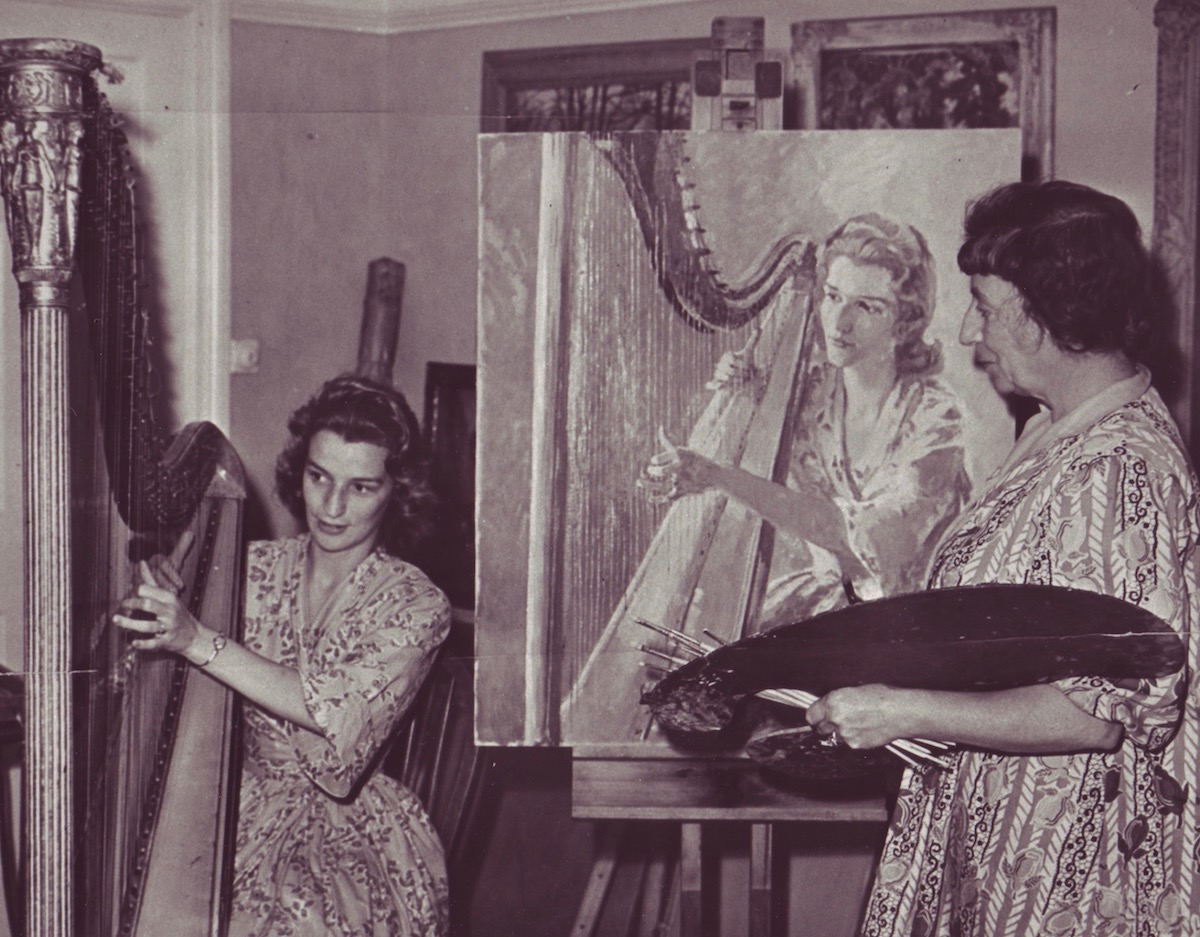
INTRODUCTION
The retrospective touring exhibition of paintings by Gladys Vasey that I researched and curated for the National Library of Wales at Aberystwyth some thirty years ago was my first such project and consequently it still holds a very special place in my affections. The lessons I learned in piecing together and reassessing a life lived through art, and presenting artworks to new audiences, were to inform all my subsequent endeavours. Over the years, the joy for me has been to: source and document artworks that have rarely if ever been exhibited; examine an artist’s life and career through the artworks themselves as well as previously untapped archival materials; interview and often make friends with the artists, their families and colleagues; reevaluate the reputations of artists overlooked or sidelined by fashion; present new knowledge and insights, through books, articles, exhibitions and public speaking, that will be useful to a wide range of beneficiaries; and, where possible, acquire for myself to enjoy around the home artworks by those I have spent much of my career studying.
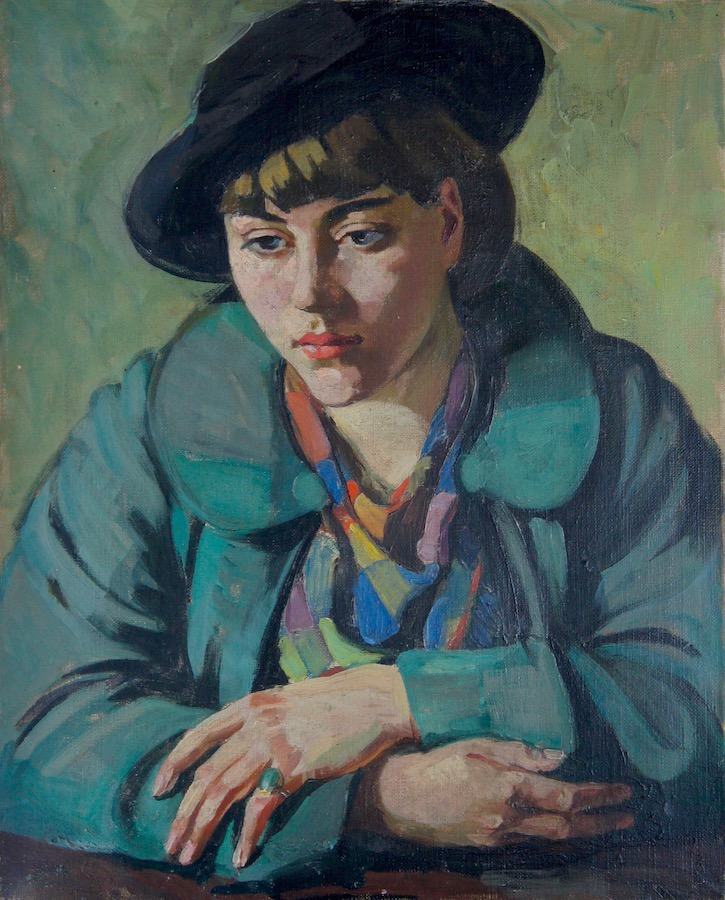
I bought locally my first Gladys Vasey portrait in 1981 for £25. At that time, the name meant nothing to me. On the back of the board was a handwritten label, ‘Eryl 25gns’. Beneath appeared to be other labels. A dampened cloth loosened the adhesive and revealed printed labels from such institutions as the Royal Society of Portrait Painters and Manchester Academy of Fine Art. Evidently Vasey, who had lived in a small cottage in nearby Aberaeron and died at Aberystwyth’s North Road Infirmary, had once enjoyed something of reputation.
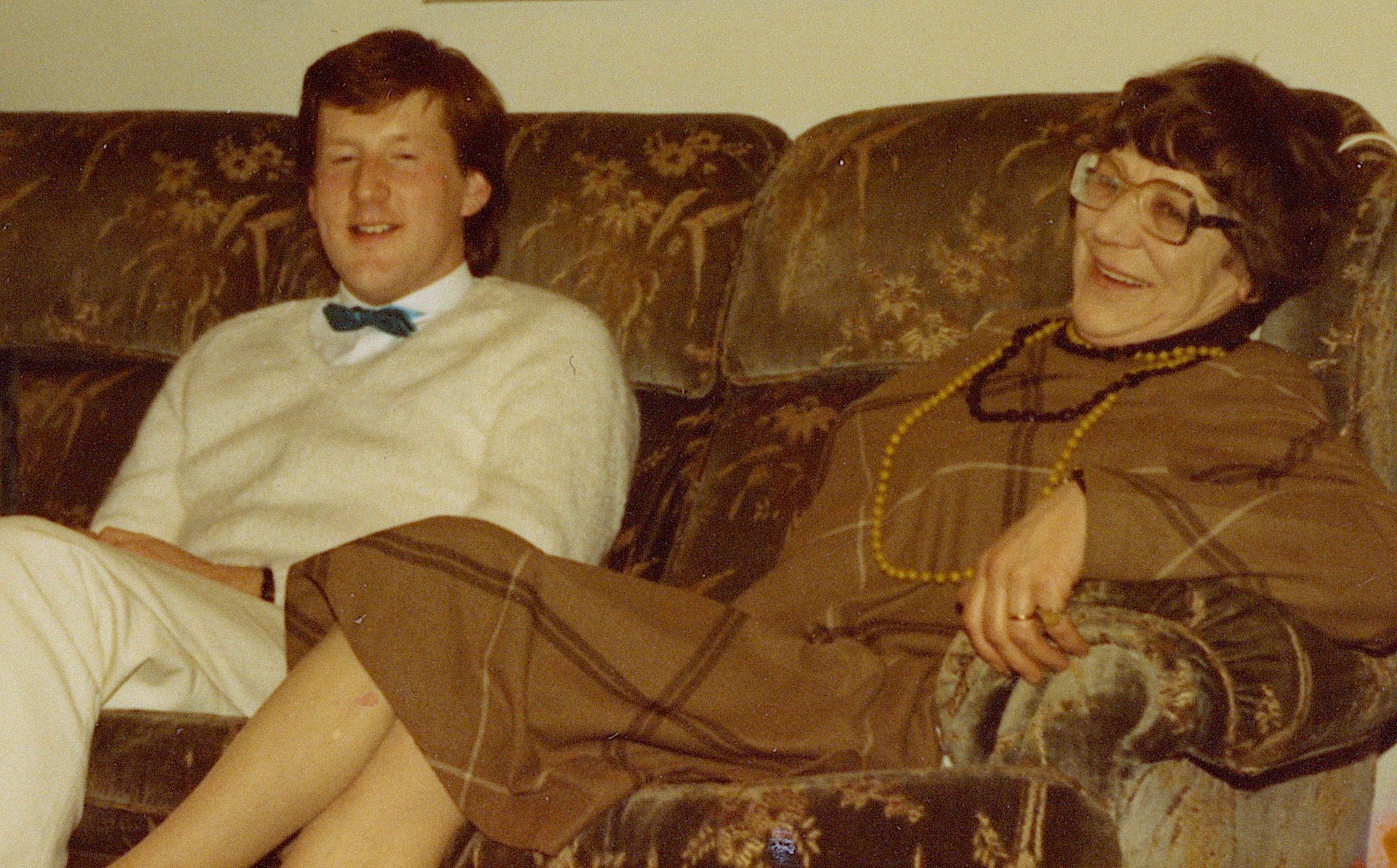
A visit to Manchester City Art revealed that Vasey had exhibited 142 paintings at the Annual Spring Exhibitions of Manchester Academy of Fine Arts. Armed with the Manchester list of exhibited works – as well as records from other societies with whom Vasey had exhibited – I trawled UK telephone directories in search of sitters or their heirs. Even in those pre-Internet days, names like Maxwell-Reekie, Wanliss-Orlebar and Shaw-Hesketh were not so difficult to trace. I also had the great good fortune to befriend the artist’s daughters Gabrielle and Madeleine. They were to point me in the direction of sitters for portraits and friends of the artist who in turn led me to other collectors of landscape and still life. Many weekends over several years I spent with Madeleine in her Shropshire home hearing of her mother, sifting through old photographs, and identifying sitters, some of whom she would invite to join us for lunch.
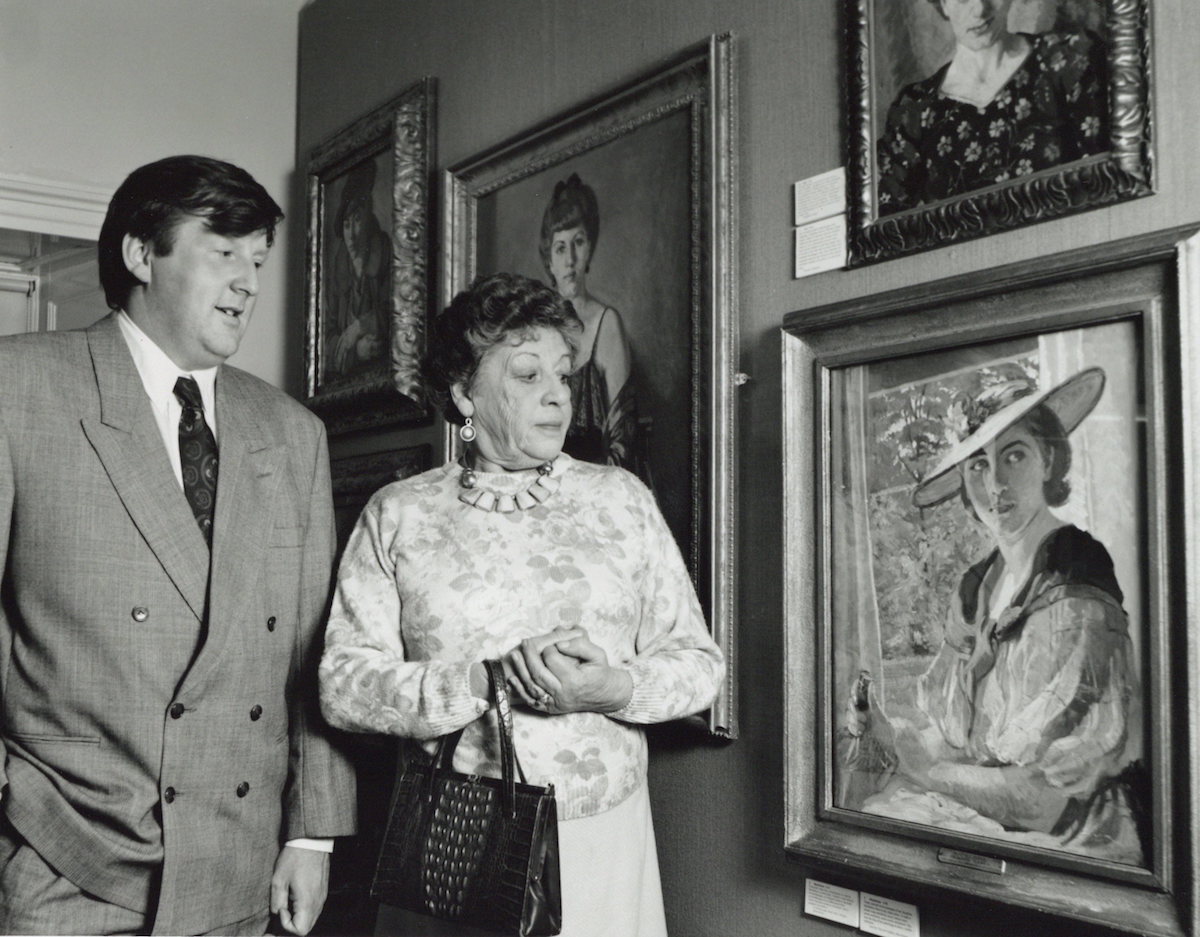
The Vasey project whet my appetite for hands-on original research working from primary sources. It encouraged me to travel, meet interesting people and visit remarkable places. Embarking on each adventure, I had no idea where the research would lead me. The detective work energized me, so too the excitement of the chase and ultimately the discovery. What then did the artworks sourced and hard-fought information garnered tell us about the artist’s practice and achievements? What did the evidence disclose? And what are the wider lessons to be learned?
There was almost no documented evidence of Vasey’s career except for one short article and a handful of letters that she wrote to Art Quarterly. I endeavored to record as much about the artist and her sitters as possible before the memory of them faded along with the generations who knew them.
The National Library of Wales exhibition brought together for the first time some 200 Vasey artworks. Alongside her many portrait commissions and paintings of distinguished sitters – painters, writers and musicians – were hung the sensitive and penetrating portraits of her family and friends. These were complemented by a range of her landscape, still life and flower paintings. While not regarded for their originality, Vasey’s portraits reveal a depth of insight and a sensitivity toward the human condition. Early career, she had witnessed the decline of figurative painting in Britain. Many of her contemporaries rejected the study of nature in favour of surrealist, abstract, action and hard-edge painting with its ever increasing demands on originality. ‘To be original,’ argued her friend, the painter Ronald Dunlop RA, in Art Quarterlyin 1959 (Vol. 3, No. 1, p. 1), ’is to be oneself […] You are what you are and no amount of cleverness or copying or simulating fashionable styles will conceal for long the real fact of what you are and how original you are. But sincerity to self is far more important than originality.’
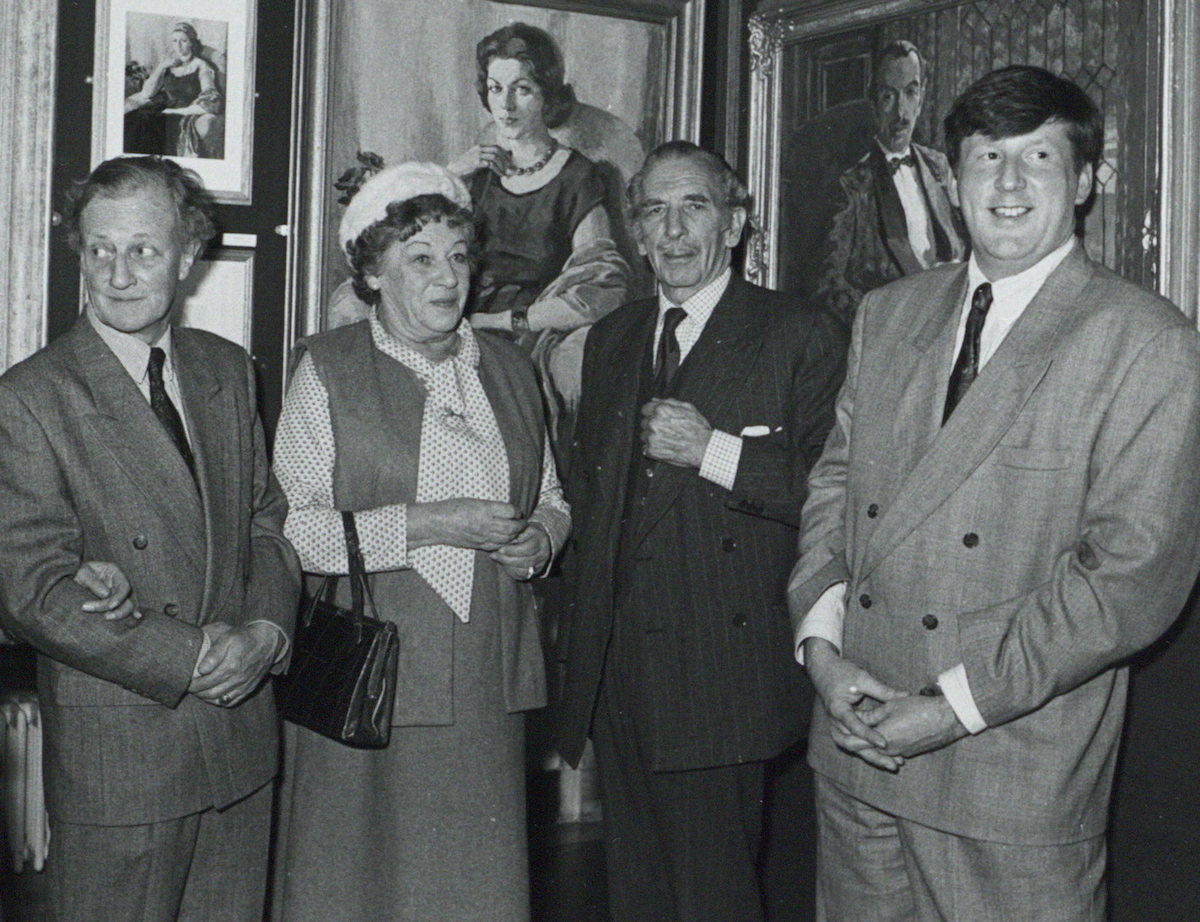
Vasey believed that abstract tendencies in contemporary painting had reached an impasse. Divorced from the ordinary person, abstract art could only communicate with the initiated. It seemed appropriate, therefore, at a time of renewed interest in the figurative tradition in British Art, that my curated exhibition should pay tribute to an artist who painted sensitively, honestly and ‘from the heart’ in a wildly capricious artistic climate.
As Robert Schumann noted in his 1849 Life Rules for Young Musicians, If your music comes from the heart and soul, and you feel it sincerely yourself, it will have the same effect on others as it has on you.
Against the Tide: The Paintings of Gladys Vasey (1889-1981)
Gladys Johnstone and her twin sister Eva were born 8 June 1889. In the last weeks of pregnancy, her mother Agnes and father Philip Johnstone – a merchantile clerk – visited Blackpool to take the air. The twins were born prematurely at Withnell Road, South Shore.
The family was of German aristocratic descent. Agnes (neé) Ellinger was of a line which could be traced to the Kauffmann family of Schwarzenberg in the Black Forest. Its most eminent member, Angelika Kauffmann, was a founder member of the Royal Academy of Art and a close friend of its first president Sir Joshua Reynolds. Agnes’ mother, Selma Rosalia (1834-1908), was the fourth of nine children born to George Wilhelm Klingelhöffer (1786-1859) and his wife Auguste Konstantia (1807-1871). On 31 August 1857, Selma Rosalia (1834-1908) married Karl Christian Ellinger (1824-1903), a book-keeper and correspondent for foreign languages in Manchester. When Karl Ellinger died, his wife returned to her family home at Emdenau north of Frankfurt am Main. Agnes and her brothers Charles and George remained in England with their families. Her twin grand-daughters Gladys and Eva were then fourteen years of age (see Theodor Klingelhöffer Geschichte der Familiie Klingelhöffer Frankfurt, 1909).
Gladys Johnstone’s paternal genealogy is less clear. Her father, Philip Tocque Johnstone, was son of Julia Tocque who belonged to the French Channel Island de Tocqueville family. Julia had married a drunken and sometimes violent Nottinghamshire miner. She was forced to leave her husband taking with her their three children: Philip, Edward and Edith. To support her young family, Julia set up a private school of dance, music and art. She assumed the name Johnstone. The actual family name is unknown.
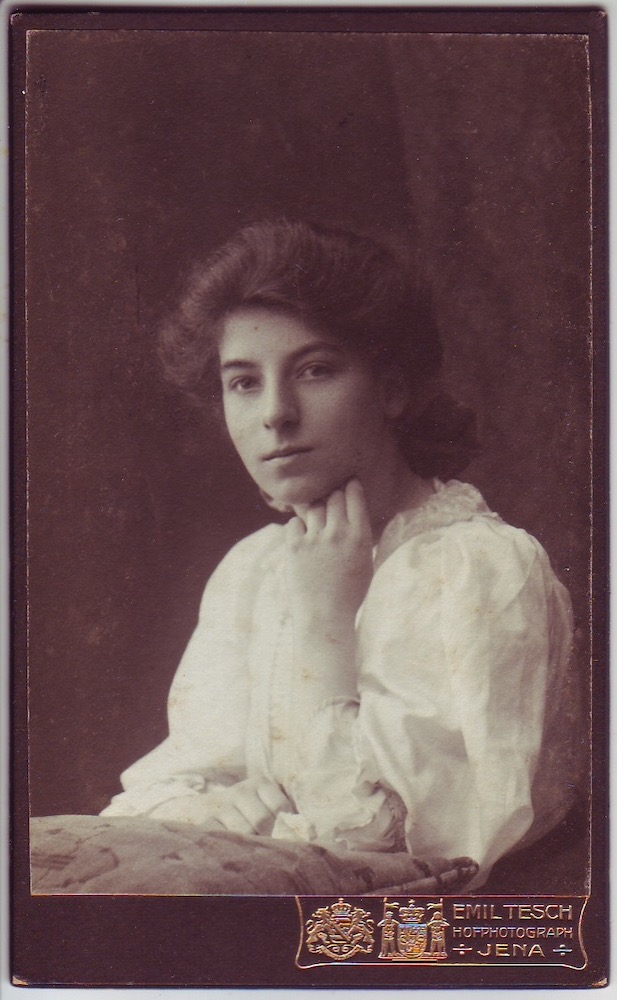
The Johnstone twins spent their childhood at Broad Road in Sale, then still a small residential town near Manchester. They attended Sale Grammar School for Girls which their father had played a part in setting up. It was not an easy childhood. Although there were no financial hardships, Agnes Johnstone was a strict mother who instilled in her daughters a sense of discipline and propriety. At seventeen the twins were sent to a finishing school in Germany to learn German and French. Gladys and Eva were alike temperamentally and they never became close. Eva remained unmarried and lived with her parents until their death. As a young woman Eva painted and exhibited, while Gladys was an accomplished pianist. She always had a piano in the house; at first an upright Bechstein, a wedding present from her parents, and later a grand piano.
Gladys Johnstone was an intelligent and receptive teenager. She would have been acquainted with the work of Manet, the Impressionists and the Post Impressionists through Roger Fry’s widely-publicised 1910 exhibition. Manchester by contrast was rich in Pre-Raphaelite and High Victorian painting from the collections of wealthy merchants and industrialists. Yet in the years leading up to the Great War, Victorian anecdotal and history painting had become unpopular.
Like her contemporary Gwen John, Gladys Johnstone rebelled against the propriety of her strict Victorian upbringing. Though she did not gain her parents’ consent to study art in Paris, she attended private painting lessons with William Fitz, a Polish artist working in Manchester. Her fellow student was the young L. S. Lowry. The evening classes improved her self-confidence and nurtured her interest in portraiture. Fitz taught her to start a portrait at the centre with the nose and eyes and to work outwards – rather than paint from the contours inward. Vasey understood the importance of drawing. It is, she wrote for Art Quarterly in 1959, is ‘as necessary to the painter and as vital to painting, as grammar is to writing, as structure is to building and form to music. Construction and imagination are two essentials to any creative work and these are entirely dependent upon each other and useless one without the other’ (Vol. 3, No. 1, p. 32).
In art galleries and in reproduction, Vasey studied the work of painters past and present whom she admired. Though little influenced by contemporary modes of expression, she was not insensitive to the work of others: her annual visit to the London exhibitions was, she wrote, ever an ‘exhilarating adventure into another world […] to see pictures; to absorb them, interpret them and learn from them’ (‘Thoughts on Burlington House’, Art Quarterly 1960 Vol. 3, No. 4, pp.156-9). Her knowledge of past schools of painting was extensive. She studied them in a selective non-academic manner as it related to her own painting. Her preferences were for De Hooch and the Dutch School, Constable and English landscape painting, the swagger portraits of John Singer Sargent and William Orpen, and most of all her illustrious contemporary Augustus John.
Gladys married Roland Vasey at Sale Independent Chapel on 31 August 1911. An insurance surveyor in Liverpool, Roland was two years her senior. The son of Baptist minister William Brown Vasey, Roland subsequently worked alongside his father-in-law Philip Johnstone who was a shipping merchants manager at Ralli Brothers, the Manchester-based bankers and leading exporter of cotton to India. Roland was posted to Birkenhead on the Wirral where the couple made their first home. In later years, Gladys talked of the unhappy time she spent there away from home, adjusting to her lost independence.
In 1914, the Vaseys moved to 4 Laurel Mount, Richmond Road in Bowdon, a small town in Cheshire with views of the parks and woodland of the Bollin Valley. It was a favourite residential area for Manchester businessmen. The couple had two daughters, Gabrielle Agnes (11 February 1916) and Madeleine Isobel (1 August 1922). With a young family, Vasey had little time to paint. The portraits of her mother-in-law Isobel Vasey (1928) and the commissioned portrait of the wife of Altrincham nurseryman and seedsman Florence Clibran (1929) are among her few known paintings to date from the 1920s. Her sketchbooks, however, are filled with pencil studies of the children at rest or at play.
Vasey’s responsibilities toward her daughters and managing the household stalled any aspirations she might have had of a painting career. The home bustled with activity. Her children remembered her as inventive mother who played with them. While a live-in maid attended to the daily chores, setting the fires and cooking breakfast, a cleaner came in daily and, on Mondays (Vasey’s day out in Manchester), there was a washerwoman. A Miss Kennilly provided daily nanny service for Madeleine. Vasey made many of the children’s clothes. On Fridays she helped with the weekly bake of pastries, pies and puddings. Evenings were for entertaining friends and Roland’s business acquaintances. Only in 1930, when both children were away at boarding school, could Vasey set up a studio and paint.
‘A Creative Adventure’
Initially Vasey painted family, friends and acquaintances, a varied and interesting group of musicians, writers and academics. In 1930, she began her longstanding association with the Manchester Academy of Fine Arts (MAFA) where she exhibited portraits of those close to her as well as portrait commissions of local dignitaries and businessmen. These include George Swaine, ‘The Head’, Kingsmoor School, Glossop (1932), her daughters’ co-educational school in Derbyshire, Professor Robert Oliphant Boswall (1933), Lecturer in Mechanical Engineering in the College of Technology as well as Manchester University, and his daughter Mary Boswall (1931) who was a school friend of Gabrielle. The quiet and contemplative paintings Gabrielle (1931) and Elizabeth Woollaston (1932) are typical of Vasey’s early portraiture. They are characterized by their muted colours and delicate tones which she achieved by the detailed and methodical application of thin, transparent glazes. Subdued light casts dark shadows that eliminate the closer tones, allowing the figure to merge with the background. Elizabeth Woollaston– daughter of a family friends at Bowdon – was also exhibited as The Glass Beads. Often her portraits were assigned titlesthat anonymize the sitter: The Red Scarf (1952), The Green Stole (1953) and The Black Gloves (1954). With a nod to painter James McNeil Whistler (1834-1903), Vasey also ascribed titles like Girl in Black and Gold (1946) and Girl in Black and Silver (1954). Such titles give significance to the paintings’ formal qualities rather than draw attention to the fact that both are portraits of her daughter Madeleine. The Black Gloves was painted especially for the Diamond Jubilee Annual Spring Exhibition of Modern Art at the Atkinson Art Gallery, Southport. It was painted in the hallway of Vasey’s new home in North Wales shortly after her move to Llanrwst.
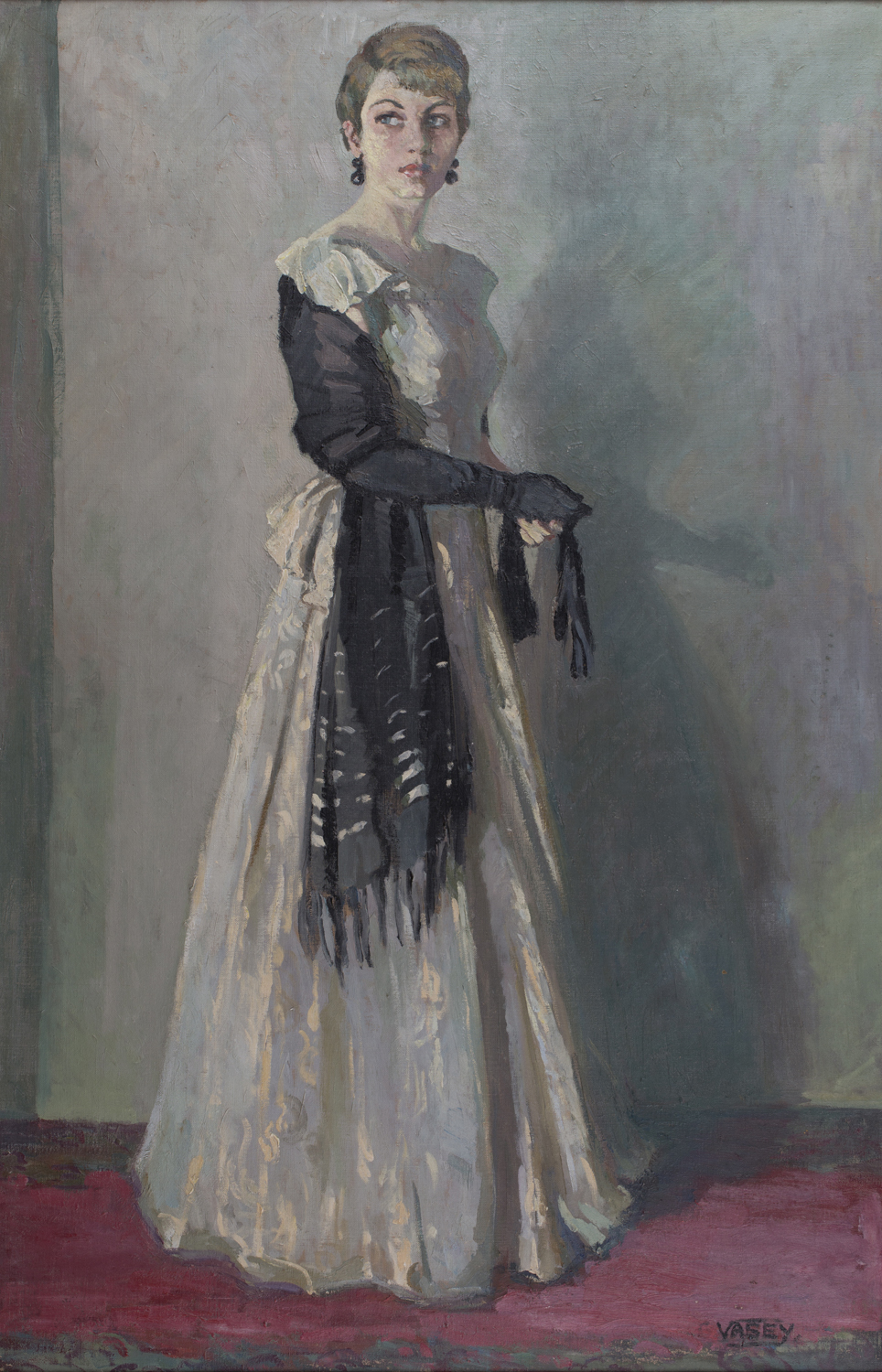
Within a few years of painting these early characterful portrait studies – of her mother-in-law Isobel Vasey (1928), daughter Gabrielle (1931), sister-in-law Lexie Hall (1931) and maid’s daughter Peggy (1931) – Vasey’s painting methods substantially changed. She rejected muted lighting and clearly define contours in favour of impasto paint and the one-layer technique of the Impressionists. The dry, chalky paint applied directly without charcoal under drawing gave the paintings a solidity intrinsic to their paint application. The change of approach followed her first visit to Cornwall where landscape painter Stanley Gardiner encouraged her to avoid the lower tones and become, as Vasey wrote to the National Library of Wales in 1973, ‘more and more in love with light and colour’.
For Vasey, the subject was paramount. She paid little attention to the backgrounds which were often hastily executed and seldom finished to the canvas edge. She was not a good technician. Old boards and canvases were turned and reused. She exhibited paintings in old gilt and gesso frames that she distressed with emulsion paint.
Vasey worked from a model whenever one was available, anyone she thought had an interesting face and was prepared to sit. She was especially attracted to faces with a story to tell: the vulnerable Eryl (1940) and the sad, mysterious face of Elizabeth in Blue (1960). Vasey had known Elizabeth Woolley as a young girl at Llanyblodwel in the 1940s. She was the daughter of the local grammar school headmaster. This is one of a series of portraits painted in the 1960s when Elizabeth visited Trefriw. In a review of the Annual Exhibition of the Society of Women Artists in 1960, the Daily Telegraph observed that this portrait showed ‘more insight than any of the others’.
All Vasey’s portraits have in common a sympathy for the human condition, but nowhere in her work has a sense of pathos been more successfully portrayed than in her 1940 portrait of Eryl. It reveals a sensitive, vulnerable and apparently complex personality. Its intensity arising from the tightly stretched skin and a penetrating stare.Gabrielle Vasey and Eryl Davies first met at college. Both were intellectual but neither were suited to University. Eryl, who was from Manchester, was half Welsh and half Scottish. Soon after they left University on completion of the first year of a Joint Honours English and Philosophy course, Gabrielle transferred to Studley Horticultural and Agricultural College for Women in Warwickshire. Eryl married a doctor from Poynton in Manchester. They had two children. She remained a close friend of Gabrielle and the Vasey family. Sometime around 1960, at Gladys Vasey’s invitation, Eryl visited with her children, the eldest of whom was then in his teens. When the time came to leave, Roland took them by car to the railway station at Llandudno Junction where Eryl put the children on the Manchester train to be met at the other end by their father. Eryl intended travelling to stay with Gabrielle in Shropshire. Instead, moments after she had waved off the children, she threw herself in the path of an oncoming train.
As journalist Mark Bourne once observed of Vasey portraits, ‘each face is given much more than it can hold at any one physical moment’ (Art Quarterly 1959, Vol. 3, No. 1, pp.12-4). Vasey’s daughters were convenient models. There are many portraits of Madeleine whose patient temperament was better suited to modelling. Preferring to occupy her time with outdoor activities, Gabrielle often refused to sit. ‘The portraits of Madeleine are more than a likeness; they are an axis,’ Bourne continues, ‘Through them runs the invisible faith of a painter round which the world of her work revolves. The Madeleine group of paintings are the core of Mrs. Vasey’s work. In this girl she was to explore and expand her own techniques – the splendid sense of construction that she has; the reticence of flesh colour; the depth of facial expression. Madeleine is the very beautiful skeleton in the cupboard of Gladys Vasey’s work.’

Familiarity with a subject gave rise to deeper understanding and insight, whether in the portraits of Madeleine and Gabrielle, or the landscapes around Llanyblodwel and later in the Conwy Valley. In Bowdon, Vasey painted portraits of musicians who were guests of her first cousin, the music administrator and composer Maurice Johnstone (1951) who lodged with her at Bayfield House. They included Julius Harrison (1943) composer and conductor, and the Hallé ‘cellist Haydon Rogerson (MAFA 1934 & 1938).
Vasey painted head and shoulders, full length, seated, reclining and standing portraits. Invariably the sitter looks directly at the observer. There is seldom background interest. The majority of her portraits are set against a loosely painted backdrop that suggests a curtain. Its colour is determined by the tonality of the head. The sitter is sometimes placed before a sunlit window to intensify the contrast and allow a more interesting colour and tonal values. In her 1940 portrait of Eryl, Vasey used interior light to create cool highlights and warm shadows that glow against the blue background. ‘In the human face,’ continued. Bourne in his Art Quarterly critique, Vasey only ‘ventures into colour – but what ventures those are. Only beside the dark of an eyebrow do you realise the light of a girl’s face; only against the grey of his own shadow, the warmth of the man’s. Gladys Vasey’s sincerity is such that it really needs more than a series of sittings to embrace its object in paint. But, slow to be won, once established, her claim on her sitter is complete. Her friends, her daughter, are seen in their entirety.’
Vasey could achieve more a likeness of the sitter, more than the literal meaning of the word ‘portrait’ from the French trait pour trait (line for line). As well as describe the colour, tone and topography of a face, she imbued the portrait with character and personality. A portrait, she asserted in a 1973 letter the National Library of Wales, ‘must be a true record of the face, catching in a moment of time the various aspects of the personality’. It was for her a ‘challenge and a creative adventure’ and, when successful, the ‘greatest thrill that a painter can have’.
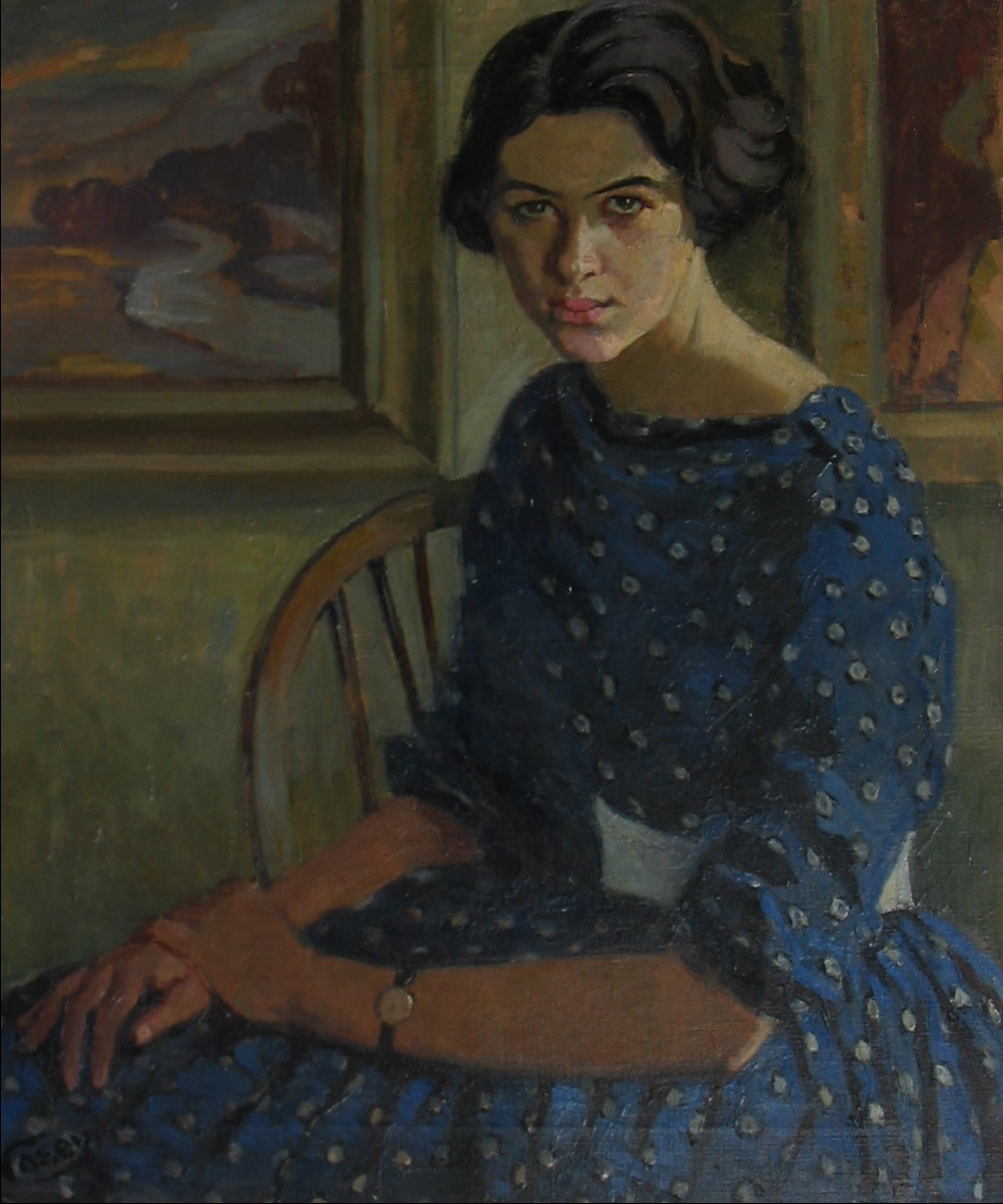
The portrait in fact can tell us as much about the artist as it can of the sitter. No portrait could claim to be a definitive representation of a sitter’s character. What we see is Vasey’s physical and emotional response to her subject observed and scrutinised over a period of time alone together in the studio. We must also be mindful that it is our experience of other people that we unknowingly project on to a portrait. Elizabeth in Blue (1960) we might see as brooding and unhappy. Eryl (1940) sensitive and nervous. Berkeley Chapple-Gill (1960) as grand and self-important. No matter what our backgrounds, we often find it easier to relate to portraits because we are so accustomed to making assumptions and passing judgement about other people, even people we have never met, in the queue at a supermarket checkout or in the pages of our daily newspapers.
In Gabrielle (1931) Vasey suggests an atmosphere of quiet contemplation by the downward angle of the head and the sitter’s preoccupied gaze – and not least in the use of diffused light and close tonal painting. By contrast, the portrait of author James Hanley (1952) is a more animated and spirited composition. The immediacy of the brushwork, the elevated tilt of the head, a stare that confronts the observer, and an energetic pose implies a captured moment in time. ‘As with the writer whose ideas have to be caught and imprisoned in words’, Vasey wrote, ‘so it is with the painter whose visions have to be compressed within the limits of his materials – and what temerity is needed by both – knowing that what is infinite must be expressed in finite terms. In art and life, the same rules apply – and the nearest approach to Truth is in direct human experience and in the knowledge based on critical judgement and finally in Reason, the touchstone of Truth!’ (‘Thoughts on Burlington House’, Art Quarterly 1960 Vol. 3, No. 4, pp.156-9).
Vasey sought to paint portraits that could be appreciated by a wider audience as works of art, paintings that go beyond a mere likeness of the sitter. Most of us who appreciate painted portraits of people we do not know are not looking for a true document of the sitter or indeed are judging whether or not Vasey achieved a good likeness. We assume a portrait to look like the sitter and represent his or her character. We are looking for other qualities. A portrait should have presence and create the illusion of being alive. It should be an elevated representation of the human condition.
Vasey’s portraits of her family and friends stand apart from her painted commissions which were expected to be a record of likeness as well as reflect the importance of the sitter. What concerned Vasey was having to suppress intellectual, aesthetic and emotional responses in order to measure up to the expectations of the audience who will have clear ideas about how the sitter should appear for posterity. She did not always find this easy and occasionally portraits were not accepted on completion.
Nevertheless, Vasey undertook numerous portrait commissions through family friends and Roland’s business contacts: William Maxwell-Reekie (1938), a Director of the Manchester textile export company of Robert Barban and Brother; George Spiegelberg (1950), a presentation portrait from his firm Mssrs. Morreau, Spiegelberg and Thompson, dealers in cotton exports in Manchester; and Sidney Whitehead (1950) commissioned by the Board of Directors for the boardroom of Stoneclough Mill to mark his retirement after forty years of service to the company. Vasey received a substantial fee of 250gns for the Whitehead portrait. She had established a name for herself in the North West of England. Despite any misgivings she might have had about official portraiture, she rarely turned down an invitation. For her such requests were an affirmation of public approval and recognition. There was never a question of having to rely on the income from commissions, or indeed the sale of other paintings. Roland Vasey provided steady financial support. Yet the commission fees she received were substantial. In the 1940s, for example, she charged as much as 200 guineas for a portrait. She sold few of the portraits that she painted of her own of family and friends.
Vasey refused to combine the camera’s vision with her own ability to control brush and paint. She never referred to a photograph when painting a portrait since the way the camera sees the world differs to the human eye. It distorts the perspective, tonal values and shadows. When Nils Severin Norem, Norwegian Honorary Consul in Manchester, asked Vasey to paint a posthumous portrait of his son from a small black and white photograph, she initially declined. However she was persuaded on learning that Flight Lieutenant Max Raymond Norem, a pilot with the 103 Squadron, had been killed in action at age 23 along with his crew on 6 March 1945 when his Lancaster was lost on an operation at Chemnitz in East Germany. At Vasey’s Llanyblodwel studio, Robin Norem sat for the portrait wearing his late brother’s Royal Air Force uniform. The photograph though did not provide sufficient information to animate the portrait, or give an impression of the hair colour and flesh tones. Portrait of an Airman is stiff and lifeless and atypical of Vasey’s portraits. In the same year, Vasey painted a three-quarter length portrait of Nils Severin Norem seated in an armchair.
Painting from Nature
Vasey painted few landscapes prior to 1936. Her interest was aroused on a painting holiday in Newlyn, Cornwall where she attended the summer art classes of Samuel John ‘Lamorna’ Birch (1869-1955). Birch’s paintings were already familiar to her. He had been an active member of the Manchester Academy of Fine Arts since 1905. Birch belonged to the small art colony centred on Lamorna village which sits at the end of a wooded valley in a scenic and secluded rockbound cove close to Newlyn. This group, which included John Armstrong and Dod Proctor, was smaller than the internationally famous Newlyn and St. Ives schools nearby.
Vasey was also acquainted with John Anthony Park (1880-1962), a painter from Preston, whose work she would have been familiar with since his election as Honorary Member of the Manchester Academy in 1927. A popular marine and landscape painter, Park lived and worked in St Ives. On at least one occasion, Park and his wife were Vasey’s guests at her Llanyblodwel home. In Lamorna, Vasey also met landscape painter and teacher Stanley Horace Gardiner (1887-1952). They became close friends. Several times she returned to Cornwall to stay as a guest of Stan and Bertha Gardiner. Vasey credited Gardiner for encouraging her to loosen her style, lighten her palette and paint against the sun. In his own work, Gardiner wished to combine the ‘art of Vincent van Gogh and that of Sir George Clausen [… to] bring about greater virility, a much needed force in present day art in this country’ (Adrian Bury Oil Painting Today Studio, 1938). Vasey’s first portrait of the lively and ebullient Gardiner was exhibited at the Manchester Academy in 1937. The second portrait, painted six years before his untimely death from throat cancer, shows Gardiner quiet and contemplative, illuminated by soft evening sunlight holding the tools of his trade.
The intense light, the mild climate, the close proximity of the small fishing villages, the sea and the countryside in the Penwith area of West Cornwall had obvious attractions for a painter from industrial Manchester. The congenial atmosphere of this artist community and the more relaxed pace of life was both inspiring and conducive to work. According to Caroline Fox, Newlyn provided painters with ‘a sort of English Concarneau’. Indeed, a number of artists who followed painter Stanhope Forbes to Newlyn had, like him, painted in Brittany. Forbes’ success at the Royal Academy Summer Exhibitions drew attention to the Newlyn School of Painters. He soon became regarded as its leader. Through Forbes, a Newlyn style developed. It was based on painting techniques learned in France and as such came to be seen as a reflection in British Art of French Impressionism. Forbes wrote of Newlyn in the Cornish Review 1878: ‘It was part of our artistic creed to paint our pictures direct from Nature, and not merely to rely upon sketches and studies which we would afterwards amplify in the comfort of a studio.’
In Birch’s classes Vasey was taught the methods of plein air-ism and the study of natural light. For subjects she chose not Forbes’ fishermen at work on the pebble beaches or variations on the harbour scene as painted by John Park. Instead she followed Birch’s example and painted in the peaceful wooded valley leading down to Lamorna Cove. At the Annual Spring Exhibition of the Manchester Academy of Fine Arts in 1937, Vasey exhibited two landscapes painted in the previous year, Lamorna Woods and Lamorna Lane both of which are now held by Manchester City Art Gallery. A third painting was her portrait, S. H. Gardiner Esq.
Recording the subtle effects of light and shade, tone and colour were for Vasey the essence of landscape painting. Painting landscapes outdoors was the only means to capture fleeting changes in weather. Unlike portraiture, where careful draughtsmanship and accuracy of form is often expected, landscape could be painted more broadly. In landscape, she wrote to the National Library of Wales in 1973, ‘there is more scope for the imagination and even distortion. Distortion may be used – never for its own sake – but to emphasise the truth, the same as in language. Therefore I find that to do a landscape as well helps one not to be photographic in portraiture.’Unlike portraiture, landscape painting allowed Vasey to exaggerate the volumes and masses and become broad and decisive.
Wales
At the outbreak of war, Vasey moved to Wales. She had stayed at Llandudno as a child and during the 1920s and 1930s visited Criccieth, Pwllheli and Black Rock with her own family. The Vaseys together with their domestic staff had spent their annual September holidays in Borth, a small seaside village north of Aberystwyth. As an industrialised city, Manchester was target for German bombing raids. Like many middle class families, the Vaseys sought refuge in the Welsh countryside. In 1939 they rented a cottage at Talybont near Aberystwyth. Roland, who had been a Conscientious Objector during the Great War, stayed in Manchester and served as an air raid warden. Madeleine left farm school at Nantwich to join her mother and sister in Wales where she worked at Aberystwyth University’s newly established Department of Dairy Bacteriology.
Borth was nearby. The large expanse of wet sands and rough seas on this exposed part of the coastline provided an ever-changing subject. Vasey worked outdoors in all weathers painting the reflections on the wet sands and the light on the stormy sea as it shone through a break in the clouds. As the sands dried quickly in the sunshine, she developed a fresh and impressionistic approach to recording the countryside.
Time passed and no end to hostilities was in sight. In July 1940, Vasey returned to Cheshire. While Gabrielle remained in Wales, Madeleine’s work took her around the country. Back in Bowdon the Vaseys sold 4, Laurel Mount and moved locally for a short time to Bayfield House, a large detached house on Stamford Road. When in 1943 Gabrielle persuaded her parents to move permanently to Wales, they bought Llan Farm at Llanyblodwel, a picturesque village on the River Tanat near Oswestry. The small black and white Montgomery-style farmhouse came with ten acres of land that their daughters managed. An outbuilding across the yard from the house was converted into a painting studio. Here Vasey spent the ten years that were undoubtedly were her most inspired and productive. Now in her late fifties, she was painting some of her finest portraits and landscapes.

The more accomplished portraits at this time include that of a minister at Llansantffraid-ym-Mechain The Reverend Glyn Jones (1945) and of his daughter Janet (1945) that won first prize at the National Eisteddfod at Mountain Ash. Twelve years later Vasey painted Janet playing the harp. Janet had become something of a celebrity when appointed first National Hostess of Wales by the Welsh Tourist Board. The portraits of Boris (1945), Madeleine in Black and Gold (1946), the poet and journalist John Eilian Jones (1952), the Lord Mayor of Manchester Alderman Thomas Henry Adams (1948), and the novelist James Hanley (1952) evidence assured brushwork and a clear perception of the essentials, reflecting her admiration for the paintings of Augustus John. Hanley lived at Llanfechain during the 1940s and met Gladys Vasey sometime after her relocation to Llanyblodwel. The portrait of Hanley is particularly arresting. The sitter’s relaxed pose suggests scholarly reflection. Hanley, who lived nearby at Llanfechain, had been introduced to the artist by Gabrielle and a ‘warm friendship developed over the years’. He had ‘great admiration for her work’. She was, he recalled to me in a letter dated 7 October 1983, a ‘devoted artist’. At Glanbrogan Hall in Llanfechain lived Reginald Moore, literary editor of Modern Reading, with his novelist wife Lisa who published under the name Elizabeth Berridge. Vasey first met the Moores in 1947. Shortly afterwards she asked Moore if he would sit for a portrait. It was painted in her studio at Llan Farm in three sittings.
Boris Tietze was a young art student at Manchester when he first saw Vasey’s paintings at the Manchester Academy in 1944. He so admired her work that he wrote her and cycled from Manchester to Llanyblodwel. She was flattered that her paintings had attracted the young man’s attentions. On three or four occasions between 1944 and 1947, he returned to Llan Farm to use Vasey’s studio and receive instruction. It was on one such visit she painted a portrait of Boris.
When Vasey painted outdoors at Llanyblodwel, she called on her daughters to carry paints, easel, canvas and brushes down the lane and through the fields. In the shade of overhanging trees she painted along the banks of the Tanat, the bridge at the heart of the village, and the distinctive church of St. Michael the Archangel with its octagonal spire, the design of artist and nineteenth-century incumbent of Llanyblodwel, the Reverend John Parker.
In need of change and a larger property, Vasey left the green meadows and tall trees of the Tanat Valley in 1953 for the equally sylvan surroundings of the Conway Valley. She lived three years at Tan-y-coed Cottage in Maenan north of Llanrwst before moving to a larger house at Trefriw on the other side of the valley. Here she took a large room as her studio where she resumed painting; in particular, Bourne points out, the view from ‘that flagged terrace where she lives, the flowers about you, and the Conwy sinuous across the green lethargy of the plain below […]’
Professional Recognition
Though Vasey never aspired to become a household name, she did wish to be taken seriously as a professional painter. Her large corpus of artworks attest to her perseverance. ‘There are times when I just do not want to paint,’ she would remark, ‘but I make myself’. She would have liked to attract the attention of fellow artists as well as critics but was aware that fashion was against her. That said, public recognition was for her less important than a personal satisfaction with her own achievements as a painter. She had a high opinion of her abilities and often met criticism with anger. ‘As regards sins,’ she wrote in a 1963 letter to Art Quarterly, ‘the one I put at the top of the list is “bad taste”, that incurable infliction of the Philistine – and incurable it seems to be, as neither religion nor education seem to have been able to influence it in any way. Wherever we go in town or country, we are hurt, offended and mortified by the preposterous and flagrant results of bad taste. Hatred and anger and scorn are the virtues with which we have to fight this growing vandalism that is the disaster of our age’ (Vol. 5, No. 3, pp.104-5). Possibly her aversion to criticism discouraged her from exhibiting in London until 1956 when she made her first contributions to Royal Society exhibitions. Ultimately, Vasey never achieved recognition beyond the Manchester Academy.
Though Vasey chose to live in some of the more remote parts of Wales, she participated in major national exhibitions. Indeed, living away from the mainstream seems to have provided ideal conditions for work. The generation of younger post-war artists who sought fame and instant success held large solo shows, but for Vasey success was to attain the recognition and appreciation of the art world by exhibiting with prestigious national and provincial art societies.
The first recorded paintings by Vasey are those included in the 1930 Annual Spring Exhibition of the Manchester Academy of Fine Arts (MAFA) staged at Manchester City Art Gallery. She continued to exhibit with the Academy in unbroken succession for 39 years. The popular exhibitions comprised some 200-300 exhibits, some by the Academy’s Honorary Members: Lamorna Birch, Henry Lamb, William Orpen, John Park and Winston Churchill.
As a non-Member of the Academy, Vasey initially exhibited by payment of a hanging fee. In 1932, however, she was elected Associate Member and was made a full Member two years later. She was henceforth eligible to submit up to five entries for selection free of charge. In 1939, she was elected Honorary Treasurer for a three year term of office. She served on the Council of MAFA (1942-7). She regularly attended the conversazione for artists, Academy subscribers and patrons. It provided her a rare opportunity to enjoy the company of other artists.
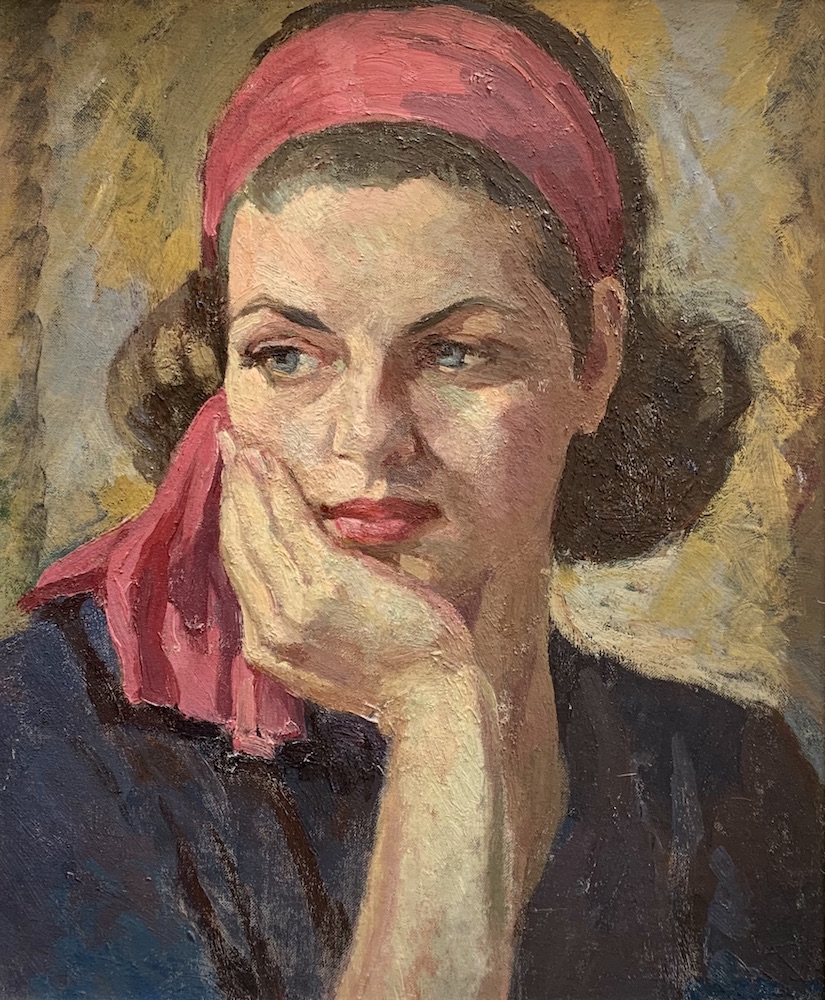
Beyond Manchester, Vasey made occasional contributions to the Annual Spring Exhibition of Modern Art at the Atkinson Art Gallery, Southport where she exhibited 12 paintings between 1931 and 1956. In 1953, she was elected an Associate Member of the Royal Cambrian Academy of Art with whom she exhibited 12 paintings between 1953 and 1955 and a single exhibit in 1958. She resigned Membership of the Royal Cambrian Academy in 1956.
In 1956 Vasey introduced her paintings to the Annual Exhibition of the Royal Society of Portrait Painters (RSPP) at the Royal Institute Galleries and the Society of Women Artists (SWA) with whom she exhibited five paintings over six years. She was elected SWA Associate Member in 1960 and a full Member in the following year. For reasons unknown, she resigned SWA membership after only two years. At the Royal Institute of Oil Painters Annual Exhibition in London she exhibited one painting in 1958 only. A number of portraits received their first showing at these exhibitions although occasionally earlier works were exhibited. Boris, for example, shown at the RSPP in 1961, had been painted 16 years earlier. They did not pass unnoticed. Several won the favourable attention of art critic and broadcaster Mervyn Levy. Of the RSPP’s annual exhibition in 1961, which included Augustus John’s Eva Kirk and Romany Lass by Dame Laura Knight, the Daily Telegraph reported that Vasey’s Portrait of Elizabeth (1960) showed ‘more insight than any of the others’.
‘Truth’s Superb Surprise’: Writings for Art Quarterly
Vasey’s opinions are most evident in her contributions to the subscription-only visual arts magazine Art Quarterly. Founded and edited by her painter friend Ronald Ossary Dunlop RA, and written by practising artists, Art Quarterly was first issued in September 1957. Vasey was a regular subscriber. From its first issue she contributed letters and exhibition reviews. The magazine endorsed the view that contemporary painting had divorced itself from the ordinary person and that art criticism, which generally favoured non-representational art, was too evasive and verbose.
Vasey first met Dunlop in Cheshire when, as a young man just out of boarding school, he lived with his parents at Hale. She gave encouragement and advice when he showed her his paintings. When in 1937 he staged an exhibition in Manchester, he wrote to Vasey to express the hope that she had not been too disappointed in him. Dunlop went on to become a distinguished painter, author and Royal Academician. Vasey painted Dunlop’s portrait at Trefriw during a brief visit early in 1956.
Art Quarterly aimed to get art out of the cul de sac into which it had been led by abstract art. It encouraged artists to return to representational painting, to look at nature and to paint objectively. ‘If it is self-revelation rather than the revelation of the reality – the picture is impure,’ Vasey wrote. ‘The self will be manifest as a result – not a cause – if, as is necessary to any composer, the artist is in a condition of love’ (‘Review of MAFA Exhibition’ Art Quarterly 1958 Vol. 1 No. 4).
In Art Quarterly, Vasey sought validation of her own beliefs. She was assured in the knowledge that many artists like her thought contemporary art ‘had reached an impasse’ and that ‘formalisation had taken the lifeblood out of the classic tradition’. She believed that ‘abstract, geometric and tachiste art ha[d] been taken to its logical conclusion’ where ‘communication with any but the initiated is possible only in so rarified an atmosphere there is nothing left to say’ (Vol. 1, No. 4 p. 149).
In the ‘Open Forum’ pages of Art Quarterly, subscribers aired their views. It is here that Vasey’s correspondences attest to her lack of sympathy with contemporary abstract painting:
How does one acquire that ambivalence of mind that is necessary for the understanding and sympathy for both “Abstract” and “Realist” Art? How does one assimilate two such divergent forms of expression? Is not “abstract” euphemism for “vacant”? There is never in human experience an object without a subject. But in these megalomaniac days – the object has become paramount and altogether obliterates the subject. The symbols become meaningless when they bear no relation to what they are supposed to represent – and if they are intended to stimulate the subconscious mind, their motive is false – for the artist, there is no barrier between the conscious and subconscious. On the other hand, why do so many of the “Realist” or representational painters see no further than facts, ignoring all mystery. This is true of so many of the portrait artists whose models appear like tailors’ dummies – lifeless and colourless creatures’
Vasey argued that the artist’s duty was to communicate with an audience that ‘must come with an open mind and the gift of adaptability’ (‘Thoughts on Burlington House’, Art Quarterly 1960 Vol. 3, No. 4, pp.156-9).
Vasey entered fewer paintings to the Annual Spring Exhibition of the Manchester Academy in the 1960s. There had been efforts to refresh the Academy by encouraging younger artists to exhibit. Attempts to represent contemporary practice were, it transpired, at the expense of more traditional idioms. Vasey did not exhibit a single painting in 1964. She broke all ties with London societies. The last painting she exhibited at the Manchester Academy of Fine Arts Annual Spring Exhibition was in 1968. She had contributed a total of 142 paintings over 39 years. This sudden and clean break was a consequence of domestic upheaval.
‘A Stubborn Gaity’: The Last Years
In 1964, at the age of 75 and after 53 years married life, Gladys left Roland for a younger man. The Vasey’s marriage had not been a happy one. Their different personalities had, however, contributed to its survival. Roland was quiet, reserved and tolerant. She was energetic, outgoing and assertive. After the children had grown up, Gladys and Roland had spent more time apart. He lived and worked in Manchester while she remained in Wales. Toward the end of her life, she claimed to have married beneath her socially. She felt Roland had not shared her interests, understood her or recognised her achievements as a professional painter. In fact, he had been more interested in her and her work than she would ever care to admit, not least in undertaking the practical arrangements for framing and the transport of pictures to exhibitions. The house at Trefriw had only recently been transferred to her name since it was assumed that Roland would predecease his wife. After the property sold, Roland spent some time with his daughter Madeleine but mostly lived out his days at a guest house in Rhos-on-Sea.
The Sumners and the Vaseys had long been friends. A little while after his wife died, James Sumner asked Gladys to live with him. They moved to Crown Cottage in Eardisland in Herefordshire where they enjoyed five years close companionship. However, Sumner died unexpectedly in 1969. For the first time Vasey was alone in life. Her twin sister, Eva Tocque Johnstone died at Bowdon on 16 July that year. She had cut herself off from Roland and her daughters and was without the financial support to which she had been accustomed.
Under sufferance, Gabrielle Vasey – who managed dog boarding kennels near Talybont – arranged during the Autumn of 1969 for her mother to live at 4 Harbour Lane in Aberaeron on the west coast of Wales. At age 80 and for the first time living by herself, she felt alone and desperately unhappy. She was a grand woman with sophisticated tastes used to a very different lifestyle surrounded by others who cared for her. She missed her friends with their tea and dinner parties and afternoon sherries. Gabrielle introduced her mother to local antique dealer Clare Herbert who in turn introduced the artist around town. In the garden of her cottage, she set up a small studio overlooking the harbour. Roland Vasey died on 22 March 1972.
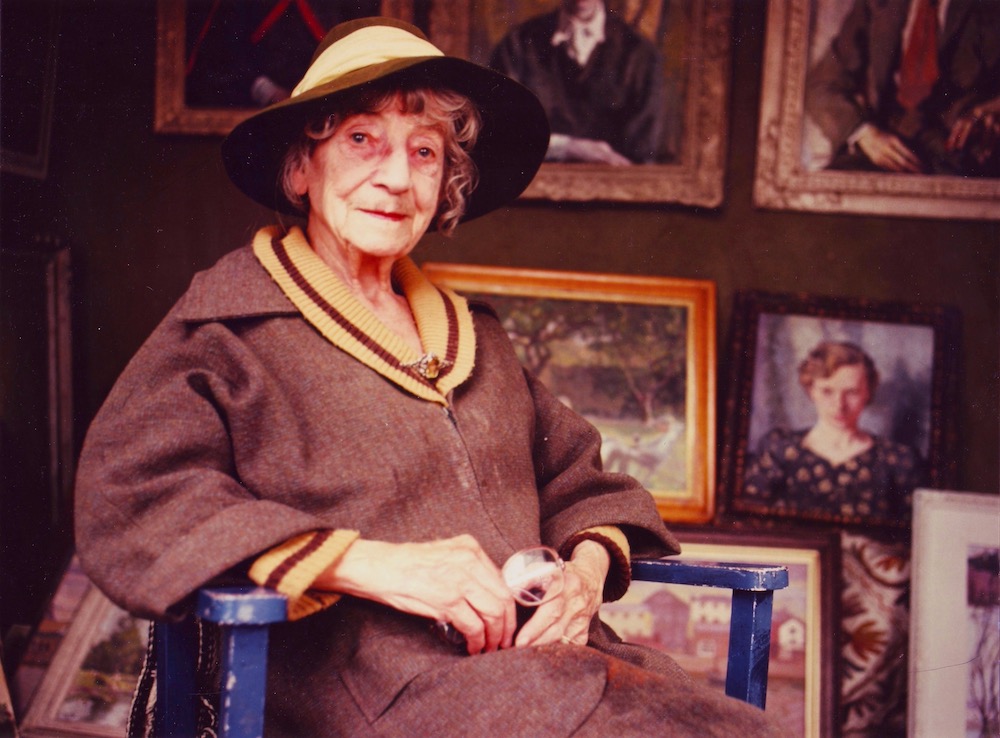
Even in old age, Vasey cut a striking figure. High spirited and alert, she remained elegant in her dress. She wore large hats, high-heeled shoes and bright clothes. She was eccentric and timeless, handsome like her mother, and possessed a deep rich voice as well as charming physical gestures. To most people who met her she seemed kind, amusing and generous, if somewhat larger than life. She loved to socialise and to share with her friends a bottle of whiskey and some cigarettes bought with the proceeds of the sales of her small paintings of the harbour. Everyone knew her as Julie. She had long thought Gladys to be a comedian’s name. It did not convey a youthful aura of modernity.
Vasey was a great conversationalist and letter writer. Glyn R. Williams wrote me how ‘she touched upon a wide spectrum of subjects and wrote of breakfast with Vivaldi and going to bed with Brahms or Beethoven; of the beauty and inspiration of colour; of the joy and failure of parenthood; of the cruelty of the Cross which obscured true light for her’ (10 October 1984). She talked of her family and in particular her children who in old age annoyed her. As young girls she could show them off with immense pride. As they became young women with minds of their own, she could no longer manipulate them. Increasingly she had seen them as rebellious. Madeleine was close to her father while Gabrielle was closer to her mother. Even so, Gabrielle admitted that she had been frightened of her all her life.
Those close to her often witnessed the darker side of her character. She could be stubborn, dominant, demanding and, when it suited her, she had – as her daughter Gabrielle pointed out to me in 1984 – ‘a tongue of verbal vitriol’ that often made her enemies. As Betty Cavendish recalled to me in a letter dated 1 August 1984, Vasey could be ‘a little tyrant when she wanted’ and ‘made demands on people which she would not care to meet if the position was reversed’. She chose her friends carefully, educated and cultured people whom she deemed to be her social equivalents, friends with whom she could have long conversations, play bridge, have afternoon tea, or go for walks and trips in the car.
At Aberaeron, Vasey painted portraits of local people, still life, views from the window and oil sketches of the harbour. These small swiftly-painted studies capture the changing weather over the harbour as well as the reflections and ripples of the sea. Vasey exhibited at the Aberaeron and District Art Society Annual Exhibitions between 1969 and 1972. In 1973 the National Library of Wales at Aberystwyth staged an exhibition of recent paintings as well as early portraits. ‘Portraits and other paintings by Gladys Vasey’ ran 5 September – 6 October in the Library’s Central Hall. For the exhibition, she painted a portrait of Margaret Evans MBE, well-known magistrate, collector and proprietor of the private museum Aberystwyth Yesterday. However, her brushwork was by now tentative and her sight had deteriorated affecting how she saw colour. In 1974 her right eye was operated on for acute glaucoma, the left in 1976. Vasey later developed cataracts. These were removed in 1977 though the left eye would not tolerate the strong magnifying spectacle lenses prescribed.
Even at age 87, Vasey could be seen in the summer months hanging the notice EXHIBITION OF PICTURES on her garden gate. This drew passer-by visitors into her studio and cottage where she would show them her paintings. Betty Cavendish, a writer who for two years worked in Wales at a nearby village, first met Vasey in 1976 when she called at the studio and was invited for coffee. In a letter dated 1 August 1983, Betty Cavendish wrote me about this and subsequent visits:
‘When I first met Julie, I thought what a delightful personality she had and what a friendly, gay, brave and amusing person to know. She had all the feelings that one would have expected of a well-brought-up woman of her period to have plus, of course, the delicate sensibilities of an artist […] She smiled and laughed easily and quickly, for many things still seemed to her wondrous about life and living and people.
[…] What I particularly remember about Julie was a kind of stubborn gaiety which, somehow or other, she could produce […] Her eyes might be paining her and she had come to realise that she would never be able to see properly again – not even after two operations on her eyes – nor would she paint again. Yet, for friendship’s sake, she would rally her forces up and get out the sherry glasses and, after a little while, colour came back into her cheeks and she smiled a little.
[…] I thought the greatest tribute to life that Julie could make, however, was in the nostalgic and gay charm of her paintings […] There seemed a trembling quality in some of her landscapes: one felt she had perceived the very moment when the tree came into leaf and shared in its struggle.’
Young Russ Norris also came to know Vasey at this time. He did odd jobs around the cottage and garden. Over the years they became very close. ‘During the interludes of pretending to be Julie’s part-time gardener,’ he wrote me in December 1984, ‘we sat in the studio and talked and drank. I played the guitar and Julie painted a most exquisite portrait of her little boy blue.’ In 1978, Norris visited Vasey with Bernard Fallon, a friend who was at the time a TV Timesphotographer. Fallon photographed Vasey in her studio. Typically she wore her painting smock and a wide-brimmed hat. Proudly she sat surrounded by a lifetime’s paintings.
Failing sight and physical weakness confined Vasey to the house where her small sitting room on a dull Autumn morning seemed ‘like a dungeon’. As she wrote to her friend Cynthia Morgan-Smith on 19 August 1979 ‘I can’t do what I want – in fact I’m only alive – but not “living”, only existing […] There are crowds here at present and I find it very hard not to be able to see their faces – only vague figures moving about in a mist.’ Using her right eye with vision that was slowly deteriorating, she painted views of the harbour from the cottage window and flowers on the sill. The portraits she began were abandoned when she could no longer see well enough to continue. Her later paintings are marred by poor sense of colour and hesitant brushwork. ‘I can neither read or do anything’, she wrote to Morgan-Smith, ‘which is devastating’.
At times bored and irritable in her old age, she wrote (in the same letter) ‘The day is dark and dull – like me! And the only way out of my dilemmas practical, physical and spiritual is to leave this earth and try the next one as soon and as noiselessly as possible –and I don’t believe that idea to be a sinful one at all.’
During Vasey’s last months, her health failed and memory became confused. She had become totally dependent on the help of others. She stayed for short periods at various nursing homes before she was eventually admitted to the North Road Infirmary at Aberystwyth. There, Gladys Vasey died in the early hours of Thursday 22 January 1981.
Robert Meyrick 1991 (revised 2018)
APPENDICES

Fascinating research.
I heard about Gladys Vasey when I worked occasionally for the late John Latter who had 2 or 3 of her paintings.
I have enjoyed your catalogue too. I wish I had seen the exhibition.
LikeLike
Sometimes she was quite brilliant but other times a bit stiff in execution. I bought one through eBay recently, perhaps in the latter category. It is somewhat redeemed I think because one of the sitters is a dog.
LikeLike
The name Philip Tocque turned up on the Antiques Road Show last evening (probably a repeat) and my husband, David Johnstone, was reminded that his paternal grandmother was Julia Tocque… this stirred up a desire to know more and our researches today arrived at Gladys Vesey whose name we both remembered. She painted a portrait of Maurice, Dave’s dad who was her uncle, a composer and head of music at the BBC’s third programme – we have a photograph of the portrait but have no idea where the original is now! Would you like us to scan the picture to add to your research? We dip in and out of family history and your research has relit our fire under a cold ‘lockdown’ sky today!
PS The Philip Tocque on the Antiques Road Show is not a relation as far as we know!
PPS We also have a photo of a portrait of Maurice by Emanuel Levy who studied in Manchester at the same time as Gladys and LS Lowry.
Best wishes
Jane (Johnstone)
LikeLike
Hello Robert !
All of a sudden it appears that a lot of stuff about Gladys has appeared on line. When I last looked her up about 4 years ago, I only saw some auction sites.
It was with considerable delight that I read all the entries today, not least the mention of Clare Herbert, my grandmother. You have clearly done a massive amount of spade work in gathering a history of a little known artist.
I do have some memories of Gladys from the mid 70’s from when I holidayed in Aberaeron. I also have three paintings of hers, given to my granny, from that latter part of her life.
If, anything I have or recall is of interest do please get in touch.
Kind regards, David
LikeLike
Very beautiful art. Thanks.
LikeLike